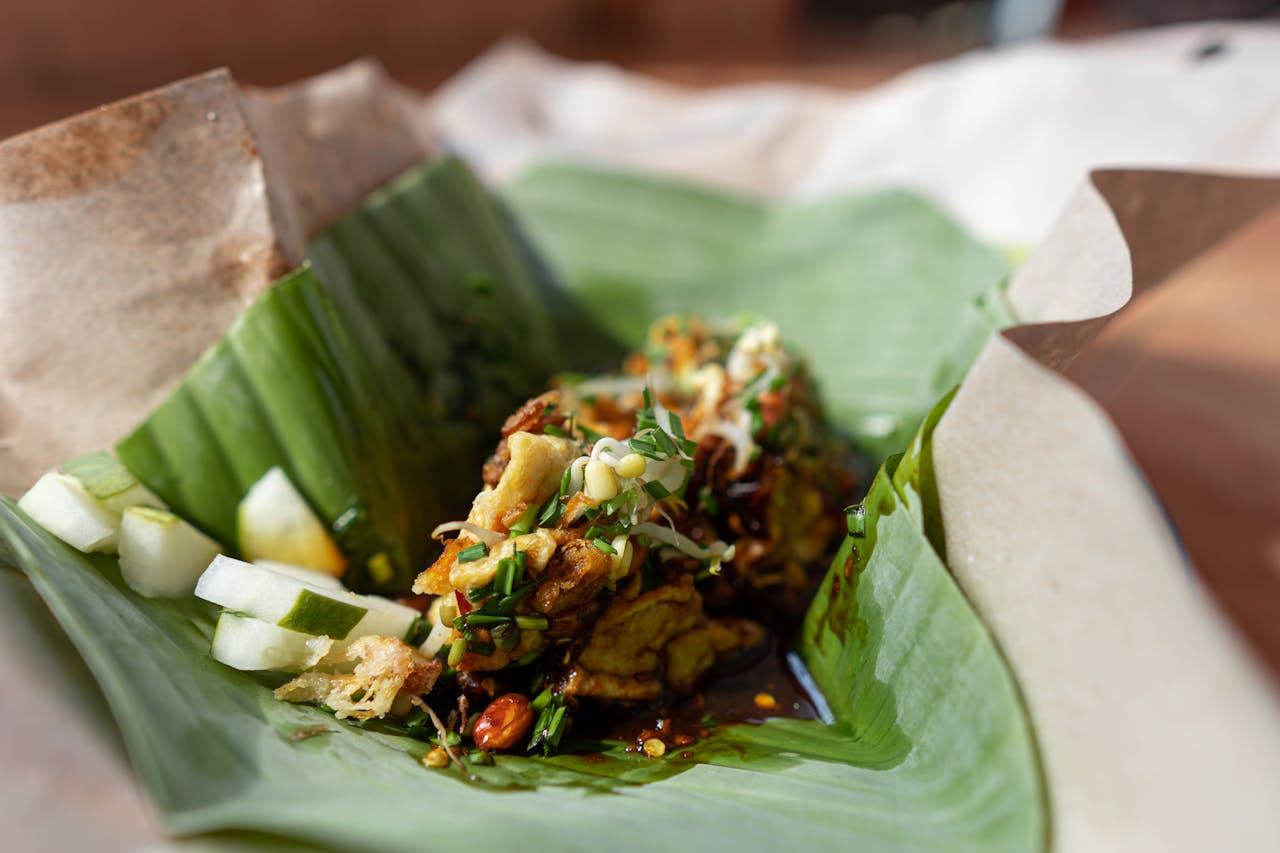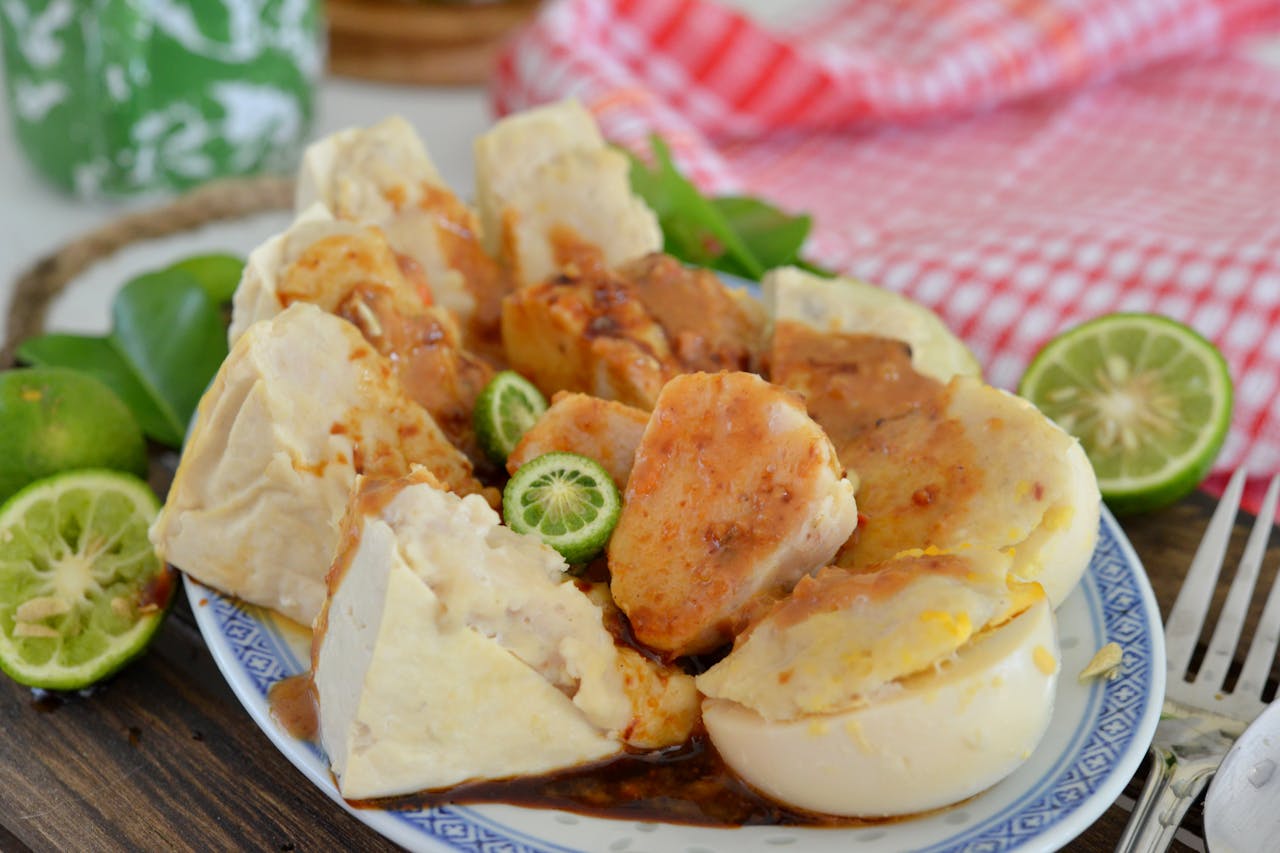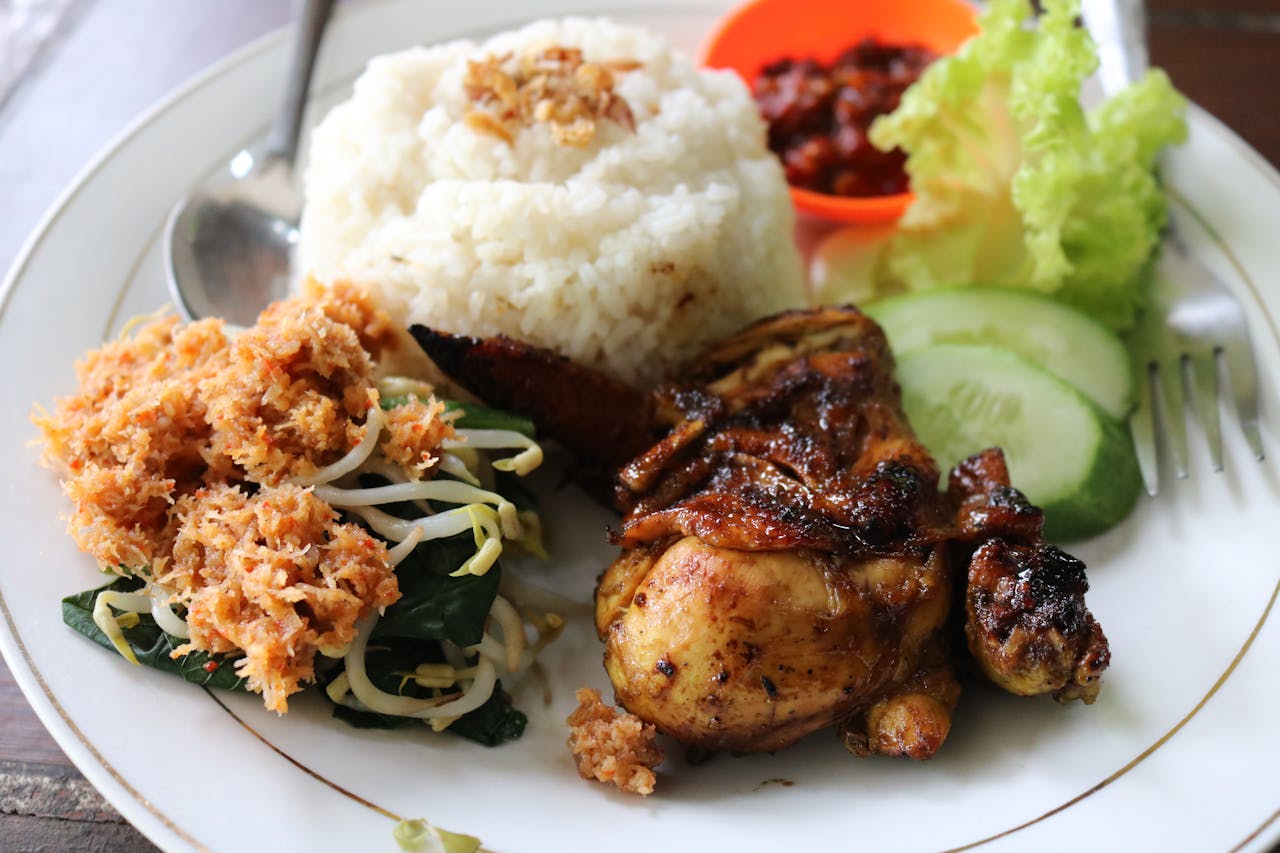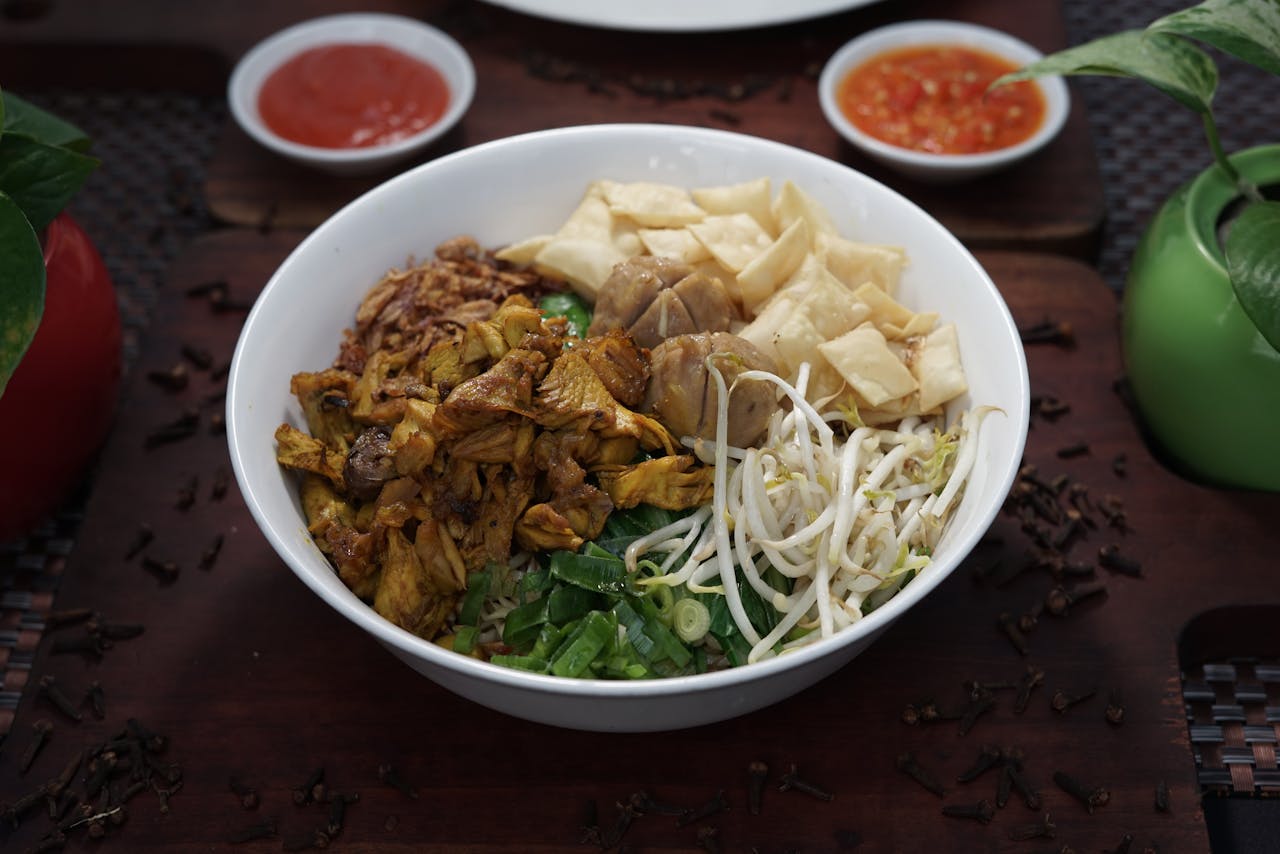
The Meaning of Traditional Javanese Food Names: Deep Meanings Behind Traditional Cuisine
Traditional Javanese food not only delights the palate but also holds profound philosophical meanings. The unique names of various traditional Javanese dishes often have specific meanings according to primbon and the beliefs of the local community. Let’s explore deeper the meanings behind these meaningful names of traditional Javanese food.
1. Understanding and History of Javanese Primbon

Indonesian food (credit: pexels.com)
Javanese Primbon is a collection of traditional knowledge of the Javanese people that has been passed down through generations. Primbon contains various predictions, guidance, and life guidelines that encompass many aspects of life, including food. The history of Primbon can be traced back to the era of the ancient Mataram kingdom.
Initially, Primbon was passed down orally from generation to generation. However, as time progressed, Primbon began to be documented in books for easier study and preservation. One famous Primbon is the Kitab Primbon Betaljemur Adammakna, compiled by Kanjeng Pangeran Harya Tjakraningrat from the Surakarta Palace in the 19th century.
In the culinary context, Javanese Primbon is often associated with the naming and meaning of various traditional dishes. The names of foods are not chosen arbitrarily, but rather contain hopes, prayers, and certain philosophies. For example, the use of words with positive meanings such as "sri" (prosperity) or "slamet" (safety) in naming foods.
2. The Philosophy Behind Javanese Food Names
The naming of food in Javanese culture is rich with philosophical meaning. Some basic principles that are often used include:
- Harmony with nature: Many food names are inspired by elements of nature such as plants, animals, or natural phenomena.
- Prayers and hopes: Food names often contain hopes for goodness, prosperity, or safety.
- Symbol of social status: Some dishes are named to reflect high social status such as "king" or "queen".
- Local wisdom: Food names can also reflect the values of local wisdom in Javanese society.
- Wordplay: Sometimes wordplay or abbreviations with hidden meanings are used.
By understanding this philosophy, we can better appreciate the cultural richness contained in traditional Javanese cuisine. These unique names are not just labels, but reflections of the worldview and noble values of the Javanese people.
3. The Deep Meaning Behind Traditional Food Names

Indonesian food (credit: pexels.com)
Let’s explore further the meanings of the names of some popular traditional Javanese foods:
1. Tumpeng
Tumpeng is cone-shaped rice served with various side dishes. The name "tumpeng" is an acronym for "tumungkulo sing mempeng" which means "to be earnest in submission to God". The cone shape symbolizes the vertical relationship between humans and the Creator.
The philosophy of tumpeng is also reflected in its side dishes:
- A whole chicken symbolizes a strong determination
- Eggs symbolize the origin of life
- Fish symbolizes perseverance
- Green vegetables symbolize fertility
Tumpeng is usually served at important events as a form of gratitude and a request for blessings.
2. Jenang Sengkolo
Jenang sengkolo is a red and white porridge that carries deep meaning. "Sengkolo" comes from the word "sangkala" which means a repellent of misfortunes or a shield against disasters. The red and white colors symbolize the origin of humans from the mother’s red blood and the father’s white sperm.
This porridge is usually served at traditional ceremonies such as tingkeban (7 months of pregnancy) with the hope that both mother and baby are always kept safe. Another meaning of jenang sengkolo is:
- A symbol of unity and harmony
- A symbol of balance in life
- A reminder of the origin of life
- A prayer to be kept away from disasters
3. Uduk Rice
Uduk rice is rice cooked with coconut milk and spices. The name "uduk" comes from the Betawi language, which means "mix." Its philosophy is to mix various elements of life to achieve harmony.
Another meaning of uduk rice:
- Symbol of prosperity and welfare
- Symbol of togetherness and mutual cooperation
- Hope that life is always blessed
- Reminder of the importance of balance in life
Uduk rice is often served at thanksgiving or selamatan events as a symbol of gratitude for the blessings received.
4. Culinary Traditions in Javanese Culture
Javanese traditional food is not only about taste but also holds various traditions and rituals rich in meaning. Some culinary traditions that are still preserved to this day include:
1. Kenduri or Selamatan
Kenduri is a communal meal held to seek safety and blessings. In kenduri, various traditional foods with symbolic meanings are served, such as:
- Rice tumpeng as a symbol of hope
- Ayam ingkung symbolizing devotion
- Banana raja as a symbol of nobility
- Market snacks symbolizing diversity
Kenduri is usually held during important moments such as births, weddings, or starting a new business. This tradition reflects the values of togetherness and gratitude in Javanese society.
2. Fasting and Breaking Fast Tradition
During the month of Ramadan, Javanese people have a unique culinary tradition when breaking their fast, such as:
- Kolak as a symbol of self-purification
- Dates symbolizing the food of the Prophet Muhammad
- Young coconut ice to refresh the body
- Various flavored Takjil as an expression of gratitude
The tradition of breaking fast with family or neighbors also reflects the values of togetherness and sharing in the teachings of Islam embraced by most Javanese people.
3. Eating Tradition in Customary Ceremonies
Various Javanese customary ceremonies always involve special food offerings, for example:
- Red and white porridge at birth ceremonies
- Yellow rice at wedding ceremonies
- Apem and sticky rice kolak at death ceremonies
- Gunungan at Grebeg ceremonies
Each food has a philosophical meaning related to the purpose of the ceremony. This tradition serves as a means to pass down cultural values from generation to generation.
5. Spiritual Meaning in Javanese Cuisine

Indonesian food (credit: pexels.com)
In addition to its philosophical meaning, many traditional Javanese foods also have deep spiritual significance. Some examples include:
1. Nasi Gurih or Nasi Uduk
Nasi gurih, cooked with coconut milk and spices, has a spiritual meaning as a symbol of prosperity and blessings. In Javanese tradition, nasi gurih is often served at sacred ceremonies such as:
- Celebration of a newborn baby
- Wedding ceremonies
- Village cleansing rituals
The serving of nasi gurih is believed to bring blessings and safety to those who eat it as well as to those who host the event.
2. Jenang Sengkolo
Jenang sengkolo or red and white porridge has deep spiritual significance. The red color symbolizes courage and spirit, while white symbolizes purity. The serving of jenang sengkolo aims to:
- Ward off misfortune or danger
- Request safety and protection
- Balance positive and negative energies
- Remind us of the origins of life
In traditional ceremonies, jenang sengkolo is often served as an offering to ancestors and spiritual forces.
3. Tumpeng
Tumpeng has a very strong spiritual meaning in Javanese tradition. The conical shape of tumpeng symbolizes the vertical relationship between humans and God. The presentation of tumpeng aims to:
- Request blessings and safety
- Express gratitude
- Unite the community
- Honor ancestors and the universe
In sacred rituals, tumpeng serves as a means to connect the real world with the spiritual realm.
6. The Influence of Primbon in Naming Modern Foods
Although times have changed, the influence of Javanese primbon can still be found in the naming of modern foods. Some examples include:
1. Use of Positive Meaning Words
Many modern restaurants or food products use Javanese words with positive meanings in their names, such as:
- "Warung Berkah" - contains the hope for blessings
- "Ayam Goreng Sejahtera" - implies prosperity
- "Bakso Nikmat" - emphasizes deliciousness
The use of these words is believed to bring positive energy and attract customers.
2. Adaptation of Traditional Food Names
Some modern foods adapt the names of traditional Javanese foods with a new twist, for example:
- "Tumpeng Pizza" - combines the concept of tumpeng with pizza
- "Sushi Pecel" - merges Japanese sushi with pecel sauce
- "Burger Rendang" - combines a burger with rendang
This adaptation aims to combine traditional values with modern tastes.
3. Use of Lucky Numbers
Some food products use numbers that are considered to bring luck in Javanese primbon, such as:
- Number 7 - considered a lucky number
- Number 9 - symbolizes perfection
- Number 5 - a symbol of balance
The use of these numbers is believed to bring good fortune to the food business.
7. Differences in the Meaning of Food Names Across Regions in Java

Indonesian food (credit: pexels.com)
Although still within the scope of Javanese culture, the meaning of food names can vary between regions. Some examples of these differences are:
1. Jenang Grendul
In Yogyakarta, jenang grendul is considered a symbol of harmony because of the small balls that unite in coconut milk broth. Meanwhile, in Solo, the same food is called "jenang ngangrang" and is regarded as a symbol of simplicity.
2. Nasi Liwet
In Solo, nasi liwet is seen as a symbol of prosperity and is used in traditional ceremonies. In Sunda, nasi liwet is more understood as an everyday food without any special ritual value.
3. Gethuk
In Magelang, gethuk is regarded as a symbol of togetherness because its preparation process requires mutual cooperation. Meanwhile, in Kediri, gethuk is more interpreted as a symbol of simplicity and local wisdom.
These differences in meaning demonstrate the rich and diverse Javanese culture, even though they are still within the same cultural family.
8. How to Preserve the Meaning of Traditional Food Names
To preserve the cultural heritage contained in the names of traditional Javanese foods, there are several efforts that can be made:
1. Documentation and Research
Conduct documentation and in-depth research on the origins and meanings of traditional food names. This can be done through:
- Interviews with elders and cultural experts
- Tracing ancient manuscripts
- Literature studies from various sources
- Collecting folklore related to food
The results of this documentation and research can then be compiled into a book or used as educational material.
2. Education for the Younger Generation
Introducing the meanings behind traditional food names to the younger generation through various methods:
- Incorporating traditional culinary material into school curricula
- Holding traditional food festivals
- Creating educational content on social media
- Conducting traditional cooking competitions
With proper education, it is hoped that the younger generation will appreciate the culinary cultural heritage more.
3. Innovation Without Losing Essence
Innovating traditional food without losing its original meaning, for example:
- Creating modern versions of traditional foods
- Packaging traditional foods in more appealing ways
- Combining the concept of traditional food with international cuisine
This innovation aims to keep traditional food relevant to contemporary tastes without losing its noble values.
9. Challenges in Preserving the Meaning of Food Names

Indonesian food (credit: pexels.com)
Preserving the meaning of traditional Javanese food names is not without challenges. Some common obstacles faced include:
1. Modernization and Globalization
The waves of modernization and globalization have a significant impact on the preservation of traditional culinary culture:
- The influx of fast food that shifts the popularity of traditional food
- Changes in lifestyle that reduce the time for cooking traditional food
- The declining interest of the younger generation in traditional cuisine
- The loss of some traditional raw materials due to environmental changes
These challenges require special strategies to ensure that traditional food continues to exist in the midst of modernization.
2. Lack of Documentation
Much knowledge about the meanings of traditional food names has not been well documented:
- The loss of elders who understand the original meanings of food names
- Minimal written literature on the philosophy of traditional food
- Differences in versions of stories about the origins of food names
- Difficulty in tracing primary sources
Serious efforts are needed to document this knowledge before it is lost to the passage of time.
3. Differences in Interpretation
There are often differences in interpretation of the meanings of food names between regions or generations:
- Differences in the interpretation of philosophical meanings among community groups
- Shifts in meaning due to changes in times
- The emergence of new interpretations that sometimes contradict the original meanings
- Difficulty in determining the most authentic version
This challenge requires dialogue and in-depth studies to achieve a more comprehensive understanding.
10. The Role of Society in Preserving the Meaning of Food Names
The preservation of the meaning of traditional Javanese food names requires the active role of various elements of society:
1. Family
The family plays an important role as the smallest unit in society:
- Teaching children about the meaning of traditional food
- Getting accustomed to cooking and serving traditional food at home
- Sharing stories behind the names of the food
- Involving children in the process of making traditional food
With the active role of the family, cultural values can be instilled from an early age.
2. Educational Institutions
Schools and universities can contribute through:
- Incorporating material about traditional cuisine into the curriculum
- Organizing extracurricular activities for cooking traditional food
- Conducting academic research on the philosophy of Javanese food
- Holding seminars or workshops on traditional cuisine
Educational institutions play a crucial role in systematically instilling knowledge.
3. Communities and Cultural Activists
Cultural communities and their activists can contribute through:
- Holding traditional food festivals
- Creating educational content on social media
- Organizing cooking classes for traditional food
- Documenting and publishing the meanings of food names
The role of the community is very important in maintaining the spirit of cultural preservation in society.
11. Conclusion

Indonesian food (credit: pexels.com)
The names of traditional Javanese foods hold a wealth of meaning that reflects local wisdom and the noble values of society. From tumpeng, which symbolizes a vertical relationship with God, to jenang sengkolo, which represents the balance of life, each dish has a profound philosophy that deserves to be preserved.
Despite facing various challenges in the modern era, efforts to preserve the meaning of traditional food names must continue. Active participation from various elements of society, ranging from families, educational institutions, to cultural communities, is essential in maintaining this cultural heritage.
By understanding and appreciating the meanings behind traditional food names, we not only preserve culinary wealth but also nurture the identity and noble values of the nation. Let us work together to keep this cultural heritage alive so that it can be enjoyed by future generations.
(kpl/dhm)
Disclaimer: This translation from Bahasa Indonesia to English has been generated by Artificial Intelligence.



















